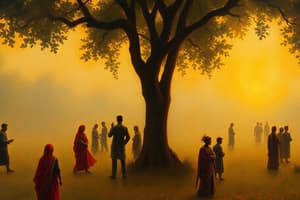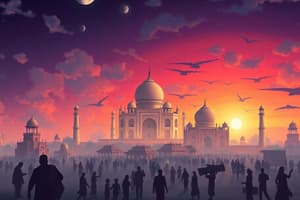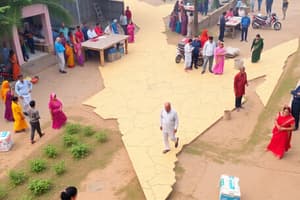Podcast
Questions and Answers
If the birth rate in a country is 20 per thousand and the death rate is 8 per thousand, what is the rate of natural population increase, expressed as a percentage?
If the birth rate in a country is 20 per thousand and the death rate is 8 per thousand, what is the rate of natural population increase, expressed as a percentage?
- 1.2% (correct)
- 2.8%
- 0.8%
- 2.0%
Which of the following factors is LEAST likely to influence the population density of a region?
Which of the following factors is LEAST likely to influence the population density of a region?
- Availability of water resources
- Government policies on industrial development
- Climate and soil fertility
- Religious composition of the population (correct)
A country has a high birth rate and a declining death rate. What stage of the demographic transition is this country MOST likely experiencing?
A country has a high birth rate and a declining death rate. What stage of the demographic transition is this country MOST likely experiencing?
- Stage 1: High Stationary
- Stage 2: Early Expanding (correct)
- Stage 4: Low Stationary
- Stage 3: Late Expanding
How might a low literacy rate, particularly among women, impact a nation's population growth?
How might a low literacy rate, particularly among women, impact a nation's population growth?
What is the MAIN objective of the National Population Policy (NPP)?
What is the MAIN objective of the National Population Policy (NPP)?
Which of the following scenarios would MOST likely result in an increased dependency ratio?
Which of the following scenarios would MOST likely result in an increased dependency ratio?
A country observes a significant increase in its life expectancy. Which of the following is the MOST likely implication of this demographic shift?
A country observes a significant increase in its life expectancy. Which of the following is the MOST likely implication of this demographic shift?
If a state has a high population density but relatively low per capita income, which of the following challenges is it MOST likely to face?
If a state has a high population density but relatively low per capita income, which of the following challenges is it MOST likely to face?
Flashcards
India's population in 2001?
India's population in 2001?
1028 million (as per Census 2001).
Most populated Indian state?
Most populated Indian state?
Uttar Pradesh.
Population density of India?
Population density of India?
324 persons per sq km (as per Census 2001).
Indian state with highest population density?
Indian state with highest population density?
Signup and view all the flashcards
Least densely populated Indian state?
Least densely populated Indian state?
Signup and view all the flashcards
Indian state with highest sex ratio?
Indian state with highest sex ratio?
Signup and view all the flashcards
Birth Rate definition?
Birth Rate definition?
Signup and view all the flashcards
What does NPP stand for?
What does NPP stand for?
Signup and view all the flashcards
Study Notes
- India's population was 1028 million in March 2001 according to the Census 2001.
- Uttar Pradesh is the most populated state in India.
- The population density in India was 324 persons per sq km in 2001.
- West Bengal is is the Indian state with the highest density of population
- Arunachal Pradesh is the least densely populated state in India.
- The population density of Arunachal Pradesh is 13 persons per sq km.
- The population density of West Bengal is 904 persons per sq km.
- Adults make up 58.7% of the Indian population.
- Children constitute 34.4% of the Indian population.
- Kerala has the highest sex ratio among Indian states.
- Kerala has 1058 females per thousand males.
- The life expectancy of an Indian in 1951 was 49 years.
- The adolescent population includes the age group of 10 to 19 years.
- NPP stands for National Population Policy.
- The National Population Policy (NPP) was framed in 2000 AD.
- India's literacy rate was 64.85% according to the 2001 census.
- Kerala's literacy rate is 90.92%.
- India comprises 16.7% of the world's population.
- Birth rate represents the number of births in a year per thousand of population.
Studying That Suits You
Use AI to generate personalized quizzes and flashcards to suit your learning preferences.




